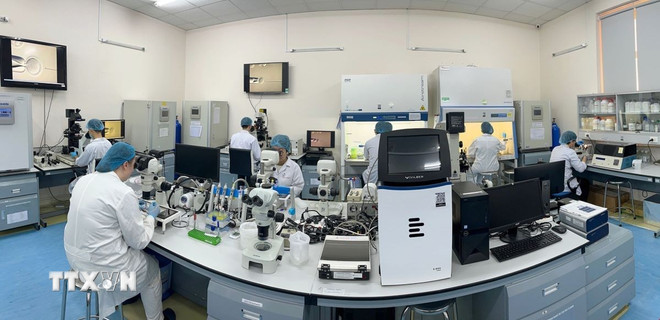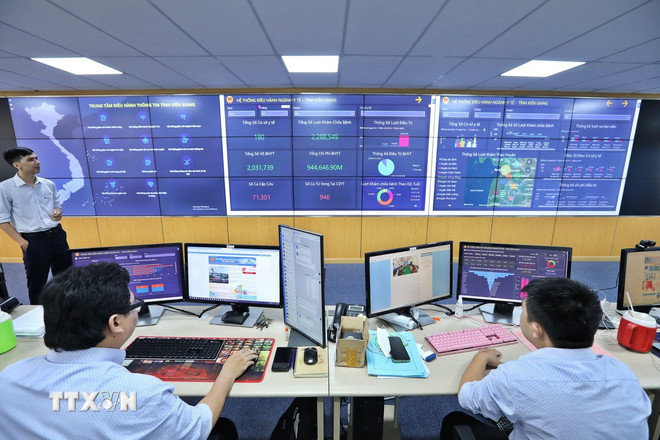The World Intellectual Property Organization (WIPO) has just released the Global Innovation Index (GII) 2025 Report, according to which Vietnam continues to maintain its ranking of 44/139 countries and economies , continuing to maintain its position in 2024.
This result affirms the Party's correct guidelines and policies, the Government's strong direction in developing the country based on science , technology and innovation, and at the same time shows Vietnam's increasingly solid position in the context of increasingly fierce global competition.
Immediately after that, the Ministry of Science and Technology promptly issued the National Index Framework to monitor and evaluate the potential, level of science, technology and innovation, demonstrating proactiveness in concretizing Resolution No. 57-NQ/TW of the Politburo, creating leverage to realize the country's strategic goals in the new era.
Affirming position on the global innovation map
According to the GII 2025 Report released on September 16, Vietnam continues to maintain its ranking of 44/139 countries and economies, among the top 50 countries with the world's leading innovation ecosystems. This is an important achievement, reflecting the effectiveness of science, technology and innovation development policies in recent years.
Notably, Vietnam was recognized by WIPO as one of the nine middle-income countries with the fastest improvement in rankings since 2013, along with China, India, the Philippines, Indonesia, Iran, Morocco, Albania and Türkiye.
For 15 consecutive years, Vietnam has achieved higher innovation results than its development level, being one of two countries holding the record along with India. Vietnam is also among the three countries with the fastest labor productivity growth rate in the period 2014-2024, along with China and Ethiopia.
In the index component, Vietnam has improved its innovation input, moving up 3 places from 53rd (in 2023) to 50th (in 2025). This is the result of focusing on institutional improvement, strengthening human resources, promoting investment in research and development (R&D), developing digital infrastructure and supporting businesses. Meanwhile, innovation output, reflecting knowledge, technology and creative products, still maintains a high position (37th), although it slightly decreased 1 place compared to 2024.
Vietnam also maintained its second place in the group of lower middle-income countries, just behind India (38th). In ASEAN, Vietnam surpassed Thailand, ranking third after Singapore and Malaysia. This is an important step forward in the region, as most of the countries ranked above Vietnam are in the high-income group, with outstanding R&D expenditure ratios compared to GDP.

Proactively implement Resolution 57
Immediately after the GII 2025 Report was published, on September 19, the Ministry of Science and Technology issued Decision 2796/QD-BKHCN on "Indicator framework for monitoring and evaluating the potential and level of national science, technology and innovation." This is a practical step to concretize Resolution No. 57-NQ/TW dated December 22, 2024 of the Politburo on breakthroughs in science, technology, innovation and national digital transformation.
The index framework is built on the basis of selecting indicators in the Global Innovation Index (GII) published annually by WIPO and science and technology fields published annually by SCImago (a research organization responsible for providing information on the quality of scientific research of countries, research institutions, and the prestige of journals through analyzing indicators based on Scopus database), with the participation of Vietnam and other countries, especially upper middle-income countries. The selected indicators ensure similarity, have clear concepts, calculation methods, and official data sources, and are published by reputable international organizations.
The index framework aims to form a set of tools to monitor and evaluate the results of implementing the goal by 2030: Potential, level of science, technology and innovation reaching advanced levels in many important fields, among the leading groups in upper-middle-income countries, according to the orientation of Resolution No. 57-NQ/TW.
The index framework is structured into two parts, including the framework for assessing science, technology and innovation potential and the framework for assessing the level of science, technology and innovation. In particular, the Potential Assessment Framework selects 35/78 GII indicators, including 19 input indicators and 16 output indicators. The meaning, calculation method, data source and results of these indicators are taken from the GII report published annually by WIPO, thereby serving to analyze and evaluate Vietnam's potential compared to upper middle-income countries.
Along with that are indicators reflecting from human resources in science and technology, investment in R&D, university capacity, to creative start-up activities and venture capital. For example: graduates in science and engineering; number of researchers; total expenditure on R&D (% GDP); average R&D expenditure of the top 3 companies with overseas investment; average score of the top 3 universities in QS ranking; finance for creative start-ups; number of venture capital deals; number of enterprises receiving venture capital; ratio of R&D expenditure of enterprises (% GDP)...
The assessment framework selects 16/27 specific fields ranked annually by SCImago. Specifically, the fields Vietnam chooses to assess the level of science, technology and innovation include Natural Sciences with 5 fields: Mathematics; Physics and Astronomy; Chemistry; Environmental Science; Earth and Planetary Science.
Science and technology with 4 fields: Computer science; Energy; Engineering; Materials science. Medical science with 3 fields: Medicine; Neuroscience; Pharmacology, toxicology and pharmacy. Agricultural science with fields: Agricultural science and biology. Social science has 2 fields: Social science; Psychology. Humanities includes 1 field: Arts and humanities.
SCImago's assessment of science and technology level is based on 3 pillars. Research performance (accounting for 50%) is assessed according to the quality and effectiveness of scientific publications, number of citations, H-index, international cooperation rate, journal quality... Innovation (accounting for 30%) is the ability to transform research results into patents, technology, and applied products. Social impact (accounting for 20%) is the level of dissemination of scientific knowledge to the community, online presence, use of scientific and technological information, and the role of women in research.

According to Associate Professor, Dr. Vu Van Tich, Deputy Director of the Academy of Strategy of the Ministry of Science and Technology, the issuance of the Index Framework is one of the tasks in Resolution No. 71/NQ-CP dated April 1, 2025 of the Government on amending and supplementing the Action Program to implement Resolution No. 57 of the Politburo. This is an important basis for ministries and branches to synchronously deploy, aiming to develop the potential of science, technology and innovation, serving the target of double-digit economic growth in the coming years. In particular, linking the target of comparison with the group of upper middle-income countries will help Vietnam have a clear direction in improving its competitiveness.
The progress in GII 2025 and the issuance of the National Index Framework demonstrate the consistency in the Party's policies, the Government's strong leadership and the support of the scientific and business community. This is clear evidence that science, technology and innovation are truly becoming key drivers of rapid and sustainable development.
Maintaining its ranking in the GII will help Vietnam achieve its higher goal of turning research results into commercialized products, improving labor productivity and national competitiveness.
In the context of increasingly fierce global competition, maintaining and upgrading the global innovation index, and effectively implementing the Index Framework to monitor and evaluate the potential, level of science, technology and national innovation will be the decisive driving force for Vietnam to realize the goal of becoming a developed, high-income country by 2045./.
Source: https://www.vietnamplus.vn/tao-don-bay-cho-viet-nam-phat-trien-khoa-hoc-cong-nghe-doi-moi-sang-tao-post1062997.vnp



















![[Video] Issuing the National Science, Technology and Innovation Assessment Index Framework](https://vphoto.vietnam.vn/thumb/402x226/vietnam/resource/IMAGE/2025/9/21/99e5dba8a7c34a27ac284bacb60f9f83)














































![[VIDEO] 50 years of Petrovietnam: Keeping the legacy alive, creating national energy](https://vphoto.vietnam.vn/thumb/402x226/vietnam/resource/IMAGE/2025/9/20/dff4ddb3d15a4076ba5f67fcdc6c7189)








































Comment (0)